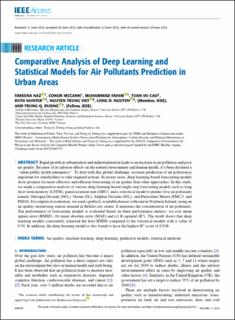| dc.contributor.author | Naz, Fareena | |
| dc.contributor.author | McCann, Conor | |
| dc.contributor.author | Fadim, Muhammad | |
| dc.contributor.author | Cao, Tuan-Vu | |
| dc.contributor.author | Hunter, Ruth | |
| dc.contributor.author | Nguyen, Trung Viet | |
| dc.contributor.author | Nguyen, Long D. | |
| dc.contributor.author | Duong, Trung Q. | |
| dc.date.accessioned | 2023-08-09T13:32:20Z | |
| dc.date.available | 2023-08-09T13:32:20Z | |
| dc.date.created | 2023-08-08T15:23:57Z | |
| dc.date.issued | 2023 | |
| dc.identifier.citation | IEEE Access. 2023, 11, 64016-64025. | en_US |
| dc.identifier.issn | 2169-3536 | |
| dc.identifier.uri | https://hdl.handle.net/11250/3083224 | |
| dc.description.abstract | Rapid growth in urbanization and industrialization leads to an increase in air pollution and poor air quality. Because of its adverse effects on the natural environment and human health, it’s been declared a “silent public health emergency”. To deal with this global challenge, accurate prediction of air pollution is important for stakeholders to take required actions. In recent years, deep learning-based forecasting models show promise for more effective and efficient forecasting of air quality than other approaches. In this study, we made a comparative analysis of various deep learning-based single-step forecasting models such as long short term memory (LSTM), gated recurrent unit (GRU), and a statistical model to predict five air pollutants namely Nitrogen Dioxide (NO 2 ), Ozone (O 3 ), Sulphur Dioxide (SO 2 ), and Particulate Matter (PM2.5, and PM10). For empirical evaluation, we used a publicly available dataset collected in Northern Ireland, using an air quality monitoring station situated in Belfast city centre. It measures the concentration of air pollutants. The performance of forecasting models is evaluated based on three performance metrics: (a) root mean square error (RMSE), (b) mean absolute error (MAE) and (c) R-squared ( R2 ). The result shows that deep learning models consistently achieved the least RMSE compared to the statistical models with a value of 0.59. In addition, the deep learning model is also found to have the highest R2 score of 0.856. | en_US |
| dc.language.iso | eng | en_US |
| dc.rights | Navngivelse 4.0 Internasjonal | * |
| dc.rights.uri | http://creativecommons.org/licenses/by/4.0/deed.no | * |
| dc.title | Comparative Analysis of Deep Learning and Statistical Models for Air Pollutants Prediction in Urban Areas | en_US |
| dc.title.alternative | Comparative Analysis of Deep Learning and Statistical Models for Air Pollutants Prediction in Urban Areas | en_US |
| dc.type | Peer reviewed | en_US |
| dc.type | Journal article | en_US |
| dc.description.version | publishedVersion | en_US |
| dc.source.pagenumber | 64016-64025 | en_US |
| dc.source.volume | 11 | en_US |
| dc.source.journal | IEEE Access | en_US |
| dc.identifier.cristin | 2165693 | |
| dc.relation.project | EU – Horisont Europa (EC/HEU): 101086541 | en_US |
| dc.relation.project | NILU - Norsk institutt for luftforskning: 122114 | en_US |
| cristin.ispublished | true | |
| cristin.fulltext | original | |
| cristin.qualitycode | 1 | |

